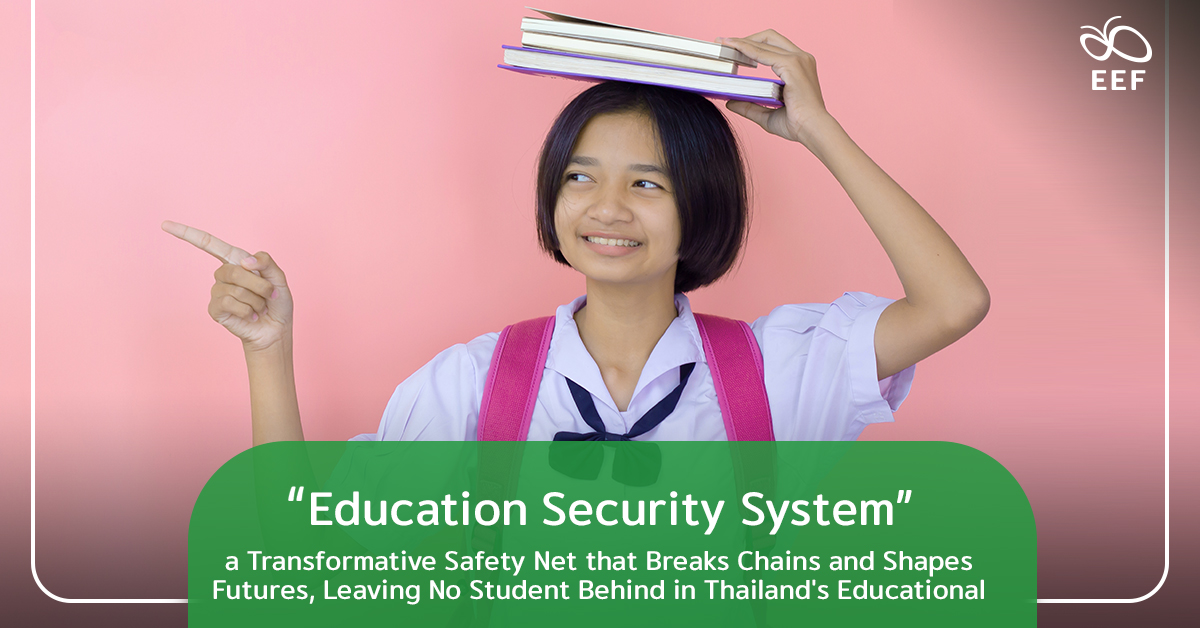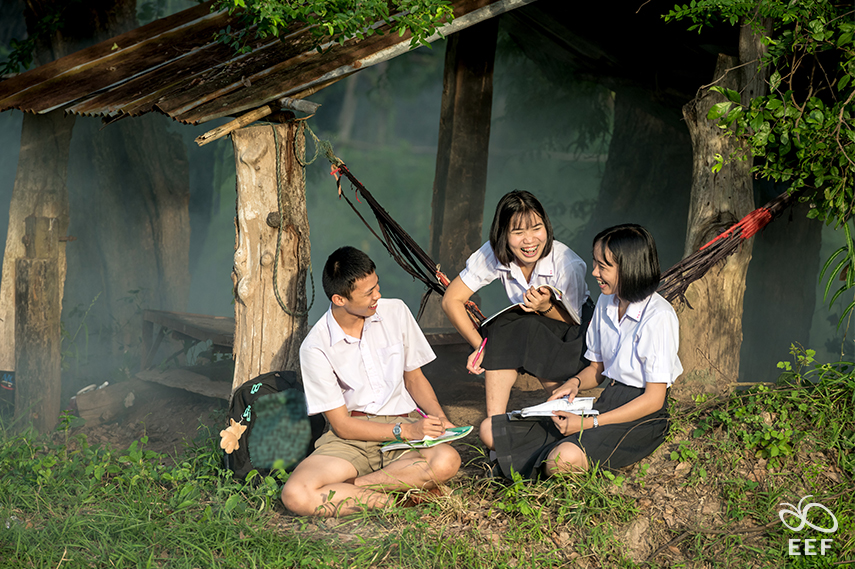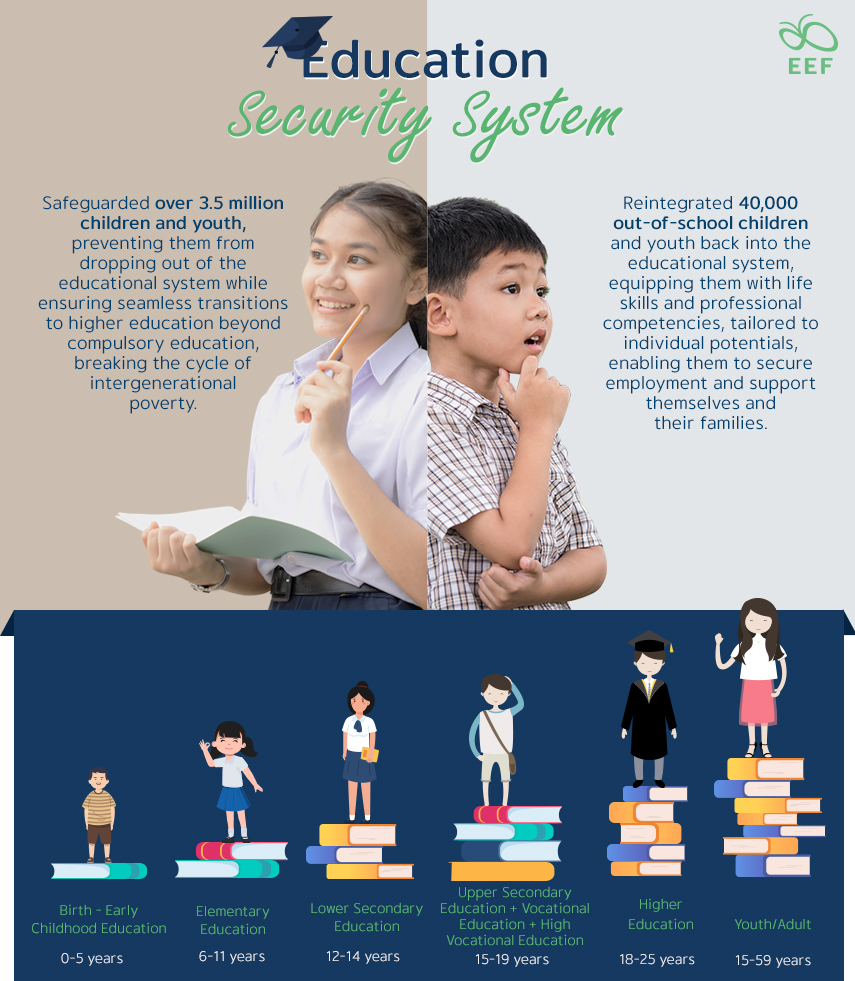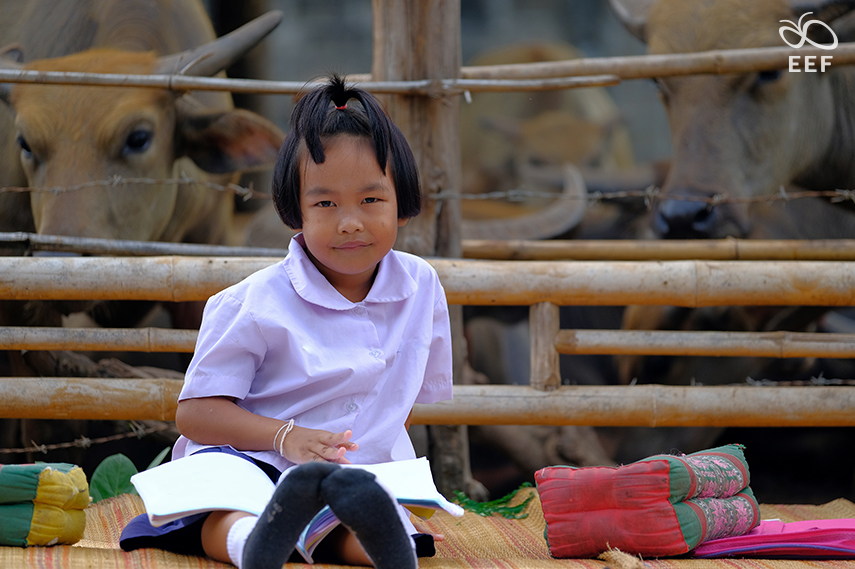
Revisiting the initial signs heralding the educational divide, 2021 data exposed a concerning reality: 30%-35% of children and youth aged 3-15 were living below the poverty line, amounting to approximately 1.1 million individuals. Despite the 15-year free education quota primarily covering tuition fees, additional expenses compounded by challenges exacerbated by the COVID-19 pandemic, such as the necessity for children to contribute to household incomes, and further aggravated by online learning disparities in tools and connectivity, significantly elevated the risk of dropout during crucial transitional periods, having already pushed the combined number of these vulnerable groups to around 1.3 million in the process — an unfortunate rebound higher than pre-COVID-19. To prevent these vulnerable children and youth from slipping through the cracks, the collaboration must be initiated, centering around three pivotal strategies: collaborative, cost-effective, and targeted.

Established in 2017, the Equitable Education Fund (EEF) Thailand is committed to this cause: ensuring economically disadvantaged children and youth successfully complete mandatory education, striving for the highest possible educational levels. Leveraging extensive data collected through annual surveys tracking millions of the most vulnerable students, it collaborates with the Ministry of Higher Education, Science, Research and Innovation (MHESI) and a university network through databases like Conditional Cash Transfer (CCT) and Thai University Central Admission System (TCAS) to support students in pursuing higher education. This collaboration has given rise to the “Education Security System” encompassing various non-repayable scholarship formats, assistance models aligned with available resources, and private sector resource mobilization.
In a meticulous effort to pinpoint economically disadvantaged students falling out of the educational system within the bottom 20% for diverse scholarships, the EEF’s Education Security System, in collaboration with the Ministry of Education, Ministry of Interior, and Thammasat University’s Faculty of Economics, employs the “Proxy Means Test (PMT)” screening process for precise identification of students in need. The ensuing support, facilitated through the CCT, extends from early childhood education to lower secondary education, covering vital aspects such as transportation and educational materials, ensuring that no obstacle hinders the educational journey of these students. To qualify for this support, students must maintain a commendable attendance rate of 80-85% and exhibit age-appropriate developmental milestones.

Beyond financial support, the Education Security System goes further by integrating databases of affiliated agencies, ensuring individualized information tracking for each student. This integration provides a comprehensive and seamless monitoring process that allows for personalized care and assistance across different agencies, creating a conducive environment for age-appropriate education. In addition, efforts extend to practical research aimed at developing a more comprehensive prevention system against dropouts. The proposals from this research cover a spectrum from kindergarten to high school, addressing educational needs across all regions.
To effectively develop the Education Security System, it is imperative to secure support beyond the cooperation and resources provided by the public sector. The system’s sustainability hinges on the contribution of data, fundraising, and resources from the private sector and enthusiastic individuals eager to contribute to the cause. Notable initiatives like “Gift to Gifted” by Central Retail have played a pivotal role in supporting transitions to upper secondary and vocational education. Furthermore, impactful projects such as “Breath of Life for Children” by PTT and “Kao Kon La Kao” by the Kao Kon La Kao Foundation have successfully reintegrated dropouts back into the educational fold. Corporate-backed endeavors like “Zero Dropout — All Children Go to School” by Sansiri and SCB, funded by bonds worth 100 million Thai Baht, have significantly aided economically disadvantaged students. The EEF actively encourages participation from all sectors, advocating for the strategic distribution of educational resources facilitated through the iSEE information technology system. This approach ensures that contributions align precisely with genuine needs, fostering the creation of a more equitable education system.

Over the past five years, the EEF’s Education Security System has safeguarded 3.5 million children and youth, preventing their disengagement from the educational system. Notably, 1.3 million students received Equity Funds, and an additional 40,000 out-of-school children and youth were reintegrated back into the system. This has led to a consistent rise in the number of economically disadvantaged students at the compulsory education level, from 994,428 in the first semester of the 2020 academic year to 1,307,152 in the first semester of the 2022 academic year, and an increase in the number of those experiencing seamless transitions to higher education or vocational paths. To put into perspective, in the 2018 academic year, there were 148,021 Grade 9 students receiving the EEF’s Equity Funds, and of these, 62,042 progressed to Grade 12 by 2021 and 20,018 secured admission rights through the TCAS system, distributed across 75 higher education institutions by 2022.
Looking ahead, the EEF’s Education Security System will be instrumental for policy-making agencies, setting and monitoring goals to promote educational equity across diverse backgrounds, from early childhood to higher education. It serves as both a policy instrument and a monitoring tool, reducing the disparity factor from 6 to 1.4, comparable to developed nations. System data also supports public policy research and development, with a particular emphasis on long-term measures for educational equity from early childhood to higher education. The goal is to instill confidence in children and youth and their families across all income levels and regions, ensuring the Thai education system provides an “educational security system.” This enables students to pursue goals based on capabilities and aspirations, rather than hindered by socio-economic standing, geographical location, or other factors.

During the 2022 academic year, households with students in the very poor group experienced a drastic reduction in average income to 1,044 Thai Baht per month, or 34 Thai Baht per day, due to COVID-19 protective measures. According to the Equitable Education Research Institute (EEFI), if all these 20,018 students successfully complete their undergraduate studies, it would contribute to an economic value of 66,000 million Thai Baht, or approximately 3.3 million Thai Baht per person throughout their lifetime. This emphasizes the pivotal role of higher education as a way out of intergenerational poverty and into national prosperity, considering that the overall cost to support children and youth to complete their undergraduate education is approximately 8,200 million Thai Baht or around 410,000 Thai Baht per person. With that being said, the EEF proposed a budget plan of 7,985,786,100 Thai Baht for the fiscal year 2024. Aligned with the 13th National Economic and Social Development Plan, this aims to efficiently address education challenges and increase funding for 1.3 million economically disadvantaged students in line with future living costs and inflation rates.
Education stands as the highest-impact, highest-return investment for a country. The Education Security System, a catalyst in overcoming barriers, has been propelling children and youth to achieve the pinnacle of educational success, in turn addressing poverty-related challenges. Not only does this foster social mobility but it also unlocks opportunities for lucrative post-education careers, ultimately shattering the chains of intergenerational poverty.
In EEF’s vision, every child, irrespective of academic prowess, deserves an equal shot at success. It is charting an expansion of the Education Security System’s reach, covering underprivileged and marginalized groups like persons with disabilities, hill tribe members, and many more. This strategic initiative is driven by the unwavering commitment to ensure that every child and young person in Thailand holds the inherent right to pursue their educational aspirations, leaving no one behind. This alignment goes beyond individual dreams; it intertwines seamlessly with the nation’s overarching objective, forging an inseparable link toward a brighter, more equitable future.

Despite being in its early stages, the Education Security System holds the transformative potential to shape inclusive educational policies throughout every crucial stage of a child’s development. Powered by an array of databases specifically designed for the nation’s most economically disadvantaged children, this system empowers a diverse range of organizations — ranging from public and private entities to civil society groups and the general public. By seamlessly integrating their efforts, these stakeholders actively contribute to guiding individuals through a comprehensive 20-year educational journey, commencing from early childhood education and extending up to the pinnacle of higher education, and in turn creating equitable education opportunities — the Equitable Education Fund’s founding principle: to reduce education inequality through research, collaboration, and support for children, youth, and adults in need.

